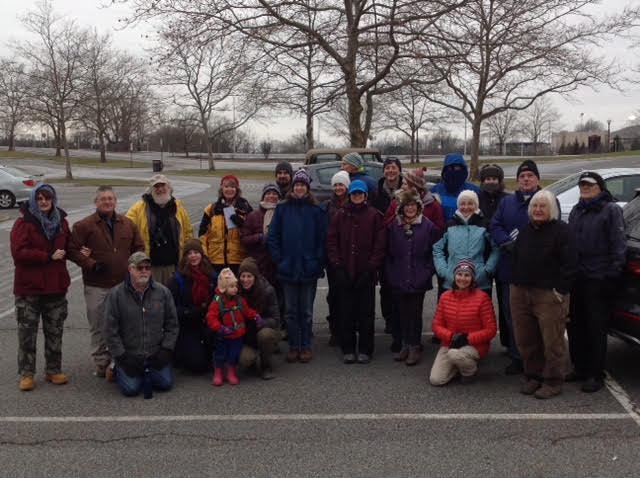
In mid-January on a Saturday morning, twenty-three people of all ages bundled to the eyes and, in terrific hats, toured Stadium Woods on Virginia Tech’s campus, to learn how to identify trees, not by summertime leaves, but by buds, bark, fragrance, flavor and form – wintertime clues and details that deepen the experience of a winter walk in the woods.
Leading the group, John Peterson, just back from taking soil samples and verifying Big Tree points in the coastal plain. Peterson has been a forestry technician for 25 years with the Department of Forest Resources and Environmental Conservation in the Virginia Tech College of Natural Resources and Environment.
Barely out of the parking lot, he stops under a gnarled black walnut, with its fuzzy terminal buds.
Identifying trees in winter is part naturalist knowledge and part detective smarts.
The first question to ask identifying tree and shrub species is “Are the twigs opposite each other or alternate, staggered left-right, up a branch?” Only a handful of species, like maples, are opposite, helpful in narrowing the field.
With the group milling around the little tree, Peterson says, “Look at the silhouette. Are the twigs opposite or alternate? Look at the bark.”
Everyone looks up at the knuckley twigs, looks down to find last fall’s walnut husks, scuffing furry duck boots and Merrell’s through piles of long black walnut leaf stems.
Snapping twigs to find cream-colored, chambered pith, chewing on the twig testing for a tell-tale black walnut bitterness.
A forest is not just a collection of trees. It’s soil, slope, water, prospect, animals and people and bounding up the hill into the woods, the last scrap of old-growth forest on campus, Peterson pauses at a small, scrawny dark tree.
Start with soil, he says. “We’re on a limestone soil called a Groseclose,” he said. “Black cherry, really common on Groseclose. The bark looks, in scientific terms, like burnt corn flakes. Beautiful wood.” The group chew on the twigs to taste the almond.
These walks attract a diversity of students, Master Naturalists, birders, foresters, whole families and just people interested in nature. Many sketch in tidy notebooks. Each group brings with them their own ecology of knowledge.
Stopping at straight grey trunk deeply furrowed bark.
“Black locust is a soil improver,” Peterson said, “it forms a symbiotic relationship with anactinomycete. Tough as nails. Its wood is unbelievably rot-resistant once it’s dry.“
Someone in the group says, “I have a cabin, built in the 40s on black locust posts. They say, ““Locust lives for 20 years, dies for 100.””
Someone else notes, “It’s an amazing host plant for moth and butterfly species.” There is conversation about the edibility of the vanilla-scented blossoms and their attractiveness to a butterfly called a Silver Spotted Skipper.
Under the looming stadium wall, the heart of Stadium Woods is a grove of centuries-old white oaks, which are magnificent and pale among scarlet oaks with streaks of red bursting through their grey bark. Black oaks are rather black. People are digging their thumb nails into the corky bark of a cucumber tree, and the conversation goes well beyond trees to fruit, birds, butterflies, bowling pins and fence posts.
The group breaks into smaller bunches crunching through leaves to examine still-green twigs of box elder and fountainy spicebushes.
“This is spice bush,” Peterson says. “It’s like a spring ephemeral with beautiful clouds of little yellow blossoms. Lipstick red fruits. Host of spicebush butterflies. It’s used as a pepper substitute.”
Passing around a snapped twig, everyone gets a spicy whiff and nods.
Box elder is a maple with green twigs in the winter, little, fuzzy buds, and a narrow, V-shaped leafscar.
Blackhaw viburnum with delicious summer fruit and fish-skeleton twigs in winter.
In the winter woods that day, chewing on minty birch twigs, examining acorns, buds and bark, for two hours, the group met at least 20 trees and understory shrubs common in the oak-hickory forests of the New River Valley.
Virginia Master Naturalists are volunteer educators, citizen scientists, and stewards helping Virginia conserve and manage natural resources and public lands.
They lead events throughout the year from the traditional to the surprising: tree walks, bird walks, wildflower walks are regularly scheduled, and they carry out beautiful and necessary efforts like frog watches, forest inventories, nightjar surveys and classes about vernal pools, medicinal plants, native landscaping and ticks.
To learn more, visit https://sites.google.com/site/nrvmasternaturalist/
This article appeared in the News Messenger newspaper, March 6, 2019.



